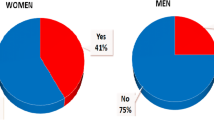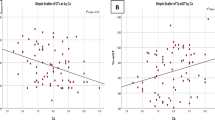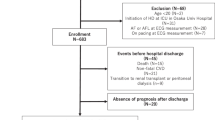Abstract
Introduction
Serum uric acid (SUA) may contribute to the increased cardiovascular damage through direct injury to the endothelium and alteration of cardiovascular function.
Aim
To evaluate the association of SUA with the presence of the most recurrent electrographic alterations and with the length of the main ECG intervals in a large sample of general population.
Methods
For this study, on the database of the Brisighella Heart Study, we evaluated the available data of 790 men and 849 women, excluding subjects affected by gout or taking antihyperuricemic agents, those taking drug increasing the QT interval and those using beta-blockers or non-dihydropyridine calcium channel blockers at the moment of the ECG registration. Multiple ascending stepwise regression analyses were carried out to determine the independent predictors of the predefined ECG alterations.
Results
The prevalence of predefined ECG alterations was comparable between genders, with the exception of sinus bradicardia, left-anterior fascicular block, atrio-ventricular blocks and left ventricular hypertrophy (LVH), which appeared to be more frequent in men. The multivariate analysis revealed that SUA was associated to ischaemic alterations, LVH, sinus tachycardia and tachyarrhytmias. Age was associated to all evaluated ECG alterations beyond sinus tachycardia and LVH. Male sex was associated to sinus bradicardia, atrio-ventricular blocks, anterior-left fascicular block and LVH. Blood pressure was associated to different ECG alterations, but with clinically relevant OR with ischaemic alterations and LVH.
Conclusion
SUA level is related the prevalence of both organic and rhythm ECG alterations in a wide sample of general population.
Similar content being viewed by others
References
Jin M, Yang F, Yang I, Yin Y, Luo JJ, Wang H, Yang XF. Uric acid, hyperuricemia and vascular diseases. Front Biosci. 2012;17:656–69.
Borghi C, Verardi FM, Pareo I, Bentivenga C, Cicero AF. Hyperuricemia and cardiovascular disease risk. Expert Rev Cardiovasc Ther. 2014;12:1219–25.
Kivity S, Kopel E, Maor E, Abu-Bachar F, Segev S, Sidi Y, Olchovsky D. Association of serum uric acid and cardiovascular disease in healthy adults. Am J Cardiol. 2013;111:1146–51.
Shi Y, Evans JE, Rock KL. Molecular identification of a danger signal that alerts the immune system to dying cells. Nature. 2003;425:516–21.
Netea MG, Kullberg BJ, Blok WL, Netea RT, van der Meer JW. The role of hyperuricemia in the increased cytokine production after lipopolysaccharide challenge in neutropenic mice. Blood. 1997;89:577–82.
Katsiki N, Karagiannis A, Athyros VG, Mikhailidis DP. Hyperuricaemia: more than just a cause of gout? J Cardiovasc Med. 2013;14(6):397–402.
Cicero AF, D’Addato S, Reggi A. Marchesini Reggiani G, Borghi C. Hepatic steatosis index and lipid accumulation product as middle-term predictors of incident metabolic syndrome in a large population sample: data from the Brisighella Heart Study. Intern Emerg Med. 2013;8:265–7.
Cicero AF, D’Addato S, Santi F, Ferroni A, Borghi C, Brisighella Heart Study. Leisure-time physical activity and cardiovascular disease mortality: the Brisighella Heart Study. J Cardiovasc Med. 2012;13:559–64.
Cicero AF, Dormi A, D’Addato S, Borghi C, Brisighella Heart Study Staff. From risk factor assessment to cardiovascular disease risk and mortality modification: the first 40 years of the Brisighella Heart Study. Clin Lipidol. 2011;6:269–76.
Cicero AF, Reggi A, Tartagni E, Grandi E, D’Addato S, Borghi C, Brisighella Heart Study. Dietary determinants of oxidized-low-density lipoprotein antibodies in a sample of pharmacologically untreated non-smoker subjects: data from the Brisighella heart study. Adv Clin Exp Med. 2013;22:69–76.
Cicero AF, Rosticci M, D’Addato S, Baronio C, Grossi G, Grandi E, Borghi C, Brisighella Heart Study Group. Population health needs assessment and healthcare services use in a three years follow-up on administrative and clinical data: results from the Brisighella Heart Study. High Blood Press Cardiovasc Dis. 2013;21:45–51.
Cicero AF, D’Addato S, Veronesi M, Rosticci M, Santi F, Dormi A, Borghi C, Brisighella Heart Study Group. Relationship between blood pressure, cholesterolemia and serum apolipoprotein B in a large population sample: the Brisighella Heart Study. J Hypertens. 2012;30:492–6.
Levey AS, Stevens LA, Schmid CH, Zhang YL, Castro AF 3rd, Feldman HI, Kusek JW, Eggers P, Van Lente F, Greene T, Coresh J, CKD-EPI (Chronic Kidney Disease Epidemiology Collaboration). A new equation to estimate glomerular filtration rate. Ann Intern Med. 2009;150:604–12.
Rautaharju PM, MacInnis PJ, Warren JW, Wolf HK, Rykers PM, Calhoun HP. Methodology of ECG interpretation in the Dalhousie program; NOVACODE ECG classification procedures for clinical trials and population health surveys. Methods Inf Med. 1990;29:362–74.
Mancia G, Fagard R, Narkiewicz K, Redón J, Zanchetti A, Böhm M, Christiaens T, Cifkova R, De Backer G, Dominiczak A, Galderisi M, Grobbee DE, Jaarsma T, Kirchhof P, Kjeldsen SE, Laurent S, Manolis AJ, Nilsson PM, Ruilope LM, Schmieder RE, Sirnes PA, Sleight P, Viigimaa M, Waeber B, Zannad F, Members Task Force. ESH/ESC Guidelines for the management of arterial hypertension: the Task Force for the management of arterial hypertension of the European Society of Hypertension (ESH) and of the European Society of Cardiology (ESC). J Hypertens. 2013;2013(31):1281–357.
Rodrigues SL, Angelo LC, Baldo MP, et al. Detection of left ventricular hypertrophy by the R-wave voltage in lead aVL: population-based study. Clin Res Cardiol. 2013;102:653–9.
Thygesen K, Alpert JS, Jaffe AS, Dantas EM, Barcelos AM, Pereira AC, Krieger JE, Mill JG, Writing Group on the Joint ESC/ACCF/AHA/WHF Task Force for the Universal Definition of Myocardial Infarction. Third universal definition of myocardial infarction. Eur Heart J. 2012;33:2551–67.
http://www.azcert.org/medical-pros/drug-lists/bycategory.cfm. Last accessed 1 Sept 2014.
Grayson PC, Kim SY, Lavalley M, et al. Hyperuricemia and incident hypertension: a systematic review and meta-analysis. Arthritis Care Res (Hoboken). 2010;63:102–10.
Bos MJ, Koudstaal PJ, Hofman A, Witteman JC, Breteler MM. Uric acid is a risk factor for myocardial infarction and stroke: the Rotterdam study. Stroke. 2006;37:1503–7.
Kim SY, Guevara JP, Kim KM, Choi HK, Heitjan DF, Albert DA. Hyperuricemia and coronary artery disease: a systematic review and meta-analysis. Arthritis Care Res. 2010;62:170–80.
Wannamethee SG, Shaper AG, Whincup PH. Serum urate and the risk of major coronary heart disease events. Heart. 1997;78:147–53.
Duan X, Ling F. Is uric acid itself a player or a bystander in the pathophysiology of chronic heart failure? Med Hypotheses. 2008;70(3):578–81.
Kaufman M, Guglin M. Uric acid in heart failure: a biomarker or therapeutic target? Heart Fail Rev. 2013;18(2):177–86.
Schwartz IF, Grupper A, Chernichovski T, Grupper A, Hillel O, Engel A, Schwartz D. Hyperuricemia attenuates aortic nitric oxide generation, through inhibition of arginine transport, in rats. J Vasc Res. 2011;48:252–60.
Zharikov S, Krotova K, Hu H, et al. Uric acid decreases NO production and increases arginase activity in cultured pulmonary artery endothelial cells. Am J Physiol Cell Physiol. 2008;295:C1183–90.
Kanellis J, Watanabe S, Li JH, Kang DH, Li P, Nakagawa T, Wamsley A, Sheikh-Hamad D, Lan HY, Feng L, Johnson RJ. Uric acid stimulates monocyte chemoattractant protein-1 production in vascular smooth muscle cells via mitogen-activated protein kinase and cyclooxygenase-2. Hypertension. 2003;41:1287–93.
Yu MA, Sánchez-Lozada LG, Johnson RJ, Kang DH. Oxidative stress with an activation of the renin-angiotensin system in human vascular endothelial cells as a novel mechanism of uric acid-induced endothelial dysfunction. J Hypertens. 2010;28(6):1234–42.
Corry DB, Eslami P, Yamamoto K, Nyby MD, Makino H, Tuck ML. Uric acid stimulates vascular smooth muscle cell proliferation and oxidative stress via the vascular renin-angiotensin system. J Hypertens. 2008;26(2):269–75.
Nyrnes A, Toft I, Njølstad I, Mathiesen EB, Wilsgaard T, Hansen JB, Løchen ML. Uric acid is associated with future atrial fibrillation: an 11-year follow-up of 6308 men and women—the Tromso Study. Europace. 2014;16:320–6.
Chao TF, Hung CL, Chen SJ, Wang KL, Chen TJ, Lin YJ, Chang SL, Lo LW, Hu YF, Tuan TC, Chen SA. The association between hyperuricemia, left atrial size and new-onset atrial fibrillation. Int J Cardiol. 2013;168(4):4027–32.
Höglund N, Andersson J, Almroth H, Tornvall P, Englund A, Rosenqvist M, Jensen SM, Boman K. The predictive value of C-reactive protein on recurrence of atrial fibrillation after cardioversion with or without treatment with atorvastatin. Int J Cardiol. 2013;167(5):2088–91.
Mandić A, Tomić M, Petrov B, Romić Z. Atrial fibrillation, atrioventricular blocks and bundle branch blocks in hemodialysis patients. Coll Antropol. 2012;36(4):1395–9.
Acknowledgments
No author has a specific conflict of interest in the publication of this paper.
We particularly acknowledge Marina Giovannini and Elisabetta Rizzoli for their support to the Brisighella Heart Study laboratory activity and Marcella Cagnati for her work on data managing. We also sincerely thank the Faenza public health district and all the General Practitioners of Brisighella for their continuous support to the study.
Funding sources
This work has been conducted with funding of the University of Bologna and with an unrestricted grant from the “Fondazione del Monte” (Bank foundation).
Author information
Authors and Affiliations
Corresponding author
Additional information
The Brisighella Heart Study: the members are listed in Appendix.
Appendix: The Brisighella Study Group
Appendix: The Brisighella Study Group
Arrigo F.G. Cicero, Martina Rosticci, Cristina Baronio, Martino Morbini, Angelo Parini, Giulia Grossi, Elisa Grandi, Sergio D’Addato, Elena Ancarani, Silvia Palmesano, Marina Giovannini, Elisabetta Rizzoli, Marcella Cagnati, Giovanni Gardini, Riccardo Urso, Giuseppe Derosa, Stefano Bacchelli, Claudio Borghi.
Rights and permissions
About this article
Cite this article
Cicero, A.F.G., Rosticci, M., Reggi, A. et al. Relationship Between Serum Uric Acid and Electrocardiographic Alterations in a Large Sample of General Population: Data From the Brisighella Heart Study. High Blood Press Cardiovasc Prev 22, 129–134 (2015). https://doi.org/10.1007/s40292-014-0077-9
Received:
Accepted:
Published:
Issue Date:
DOI: https://doi.org/10.1007/s40292-014-0077-9




